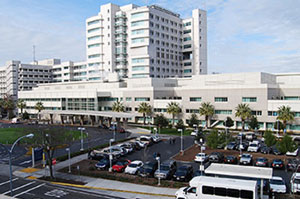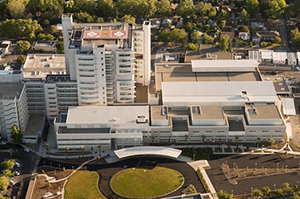UC Davis Same Day Surgery Center opens and eases pressure on California's busiest operating rooms
 The operating rooms feature some of the most advanced, state-of-the-art equipment, including booms and lights with integrated audio-visual components that support modern surgical techniques.
The operating rooms feature some of the most advanced, state-of-the-art equipment, including booms and lights with integrated audio-visual components that support modern surgical techniques.One month after its opening, UC Davis Health System’s new Same Day Surgery Center is meeting expectations set for the new facility: reducing demands on the hospital’s main operating rooms by providing an outpatient setting for low-risk, high-volume and noninvasive surgeries.
Since opening on Nov. 5, the center has been accommodating an average of 15 cases a day, and is capable of handling twice as many, said Rebecca Ogden, manager of the center, located next to the Ellison Building at Second Avenue and 49th Street. By taking on a large number of outpatient surgery cases, the center will allow the hospital’s main operating suites — the main operating suite on the second floor, main operating room on the first floor (formerly the University Surgery Center) and the Satellite Surgery Center — to accommodate an additional 900 cases a year, said Philip Schneider, director of perioperative services at the health system.
“We had a great and urgent need for more OR space, and the Surgery and Emergency Services Pavilion is not slated to open until 2010,” Schneider said. “The diligence of everyone involved has helped make the opening of the Same Day Surgery Center a great success. Moving a large volume of ambulatory cases to the center, and merging the former University Surgery Center with the main operating room has allowed for the expansion of all major inpatient surgical services.”
The majority of the cases to be performed at the Same Day Surgery Center will come from the ophthalmology and orthopaedics departments. Certain cases from otolaryngology and plastic surgery also are performed there. Health system officials anticipate that, eventually, the center will handle about 95 percent of the otolaryngology and ophthalmology outpatient cases.
Increased demand
Over the last several years, the demand for outpatient surgeries has increased, due to changes in health-care delivery and advanced surgical techniques in outpatient surgery, said Schneider. At the same time, use of the operating suites in the main hospital was increasing, creating a backlog of cases, especially for orthopaedics.
The hospital’s main operating suites had their busiest year ever in fiscal year 2006-07, when it handled 20,312 cases. It represented the fourth straight year that the caseload for the operating suites had increased. According to data collected by the University HealthSystem Consortium, the hospital’s main operating rooms are the busiest in California, Schneider said. UHC is an alliance of 97 academic medical centers and 153 of their affiliated hospitals representing approximately 90 percent of the nation’s non-profit academic medical centers.
The UHC data shows that UC Davis’ main operating rooms are first in terms of the number of minutes the operating rooms are in use, and second in terms of the number of cases performed.
What's inside
The Same Day Surgery Center has four operating rooms, 12 pre- and post-operative beds and a waiting area. The operating rooms feature some of the most advanced, state-of-the-art equipment, including booms and lights with integrated audio-visual components that support modern surgical techniques.
Suspended from the ceiling, the booms are horizontal, flexible arms that carry different items, such as carbon dioxide and cauterizing devices. Without the booms, the various equipment, wires and cables they carry would be on the floor, creating clutter and posing tripping hazards. Some of the hospital’s main operating rooms have been retrofitted with the booms, but the ceilings on most of the rooms cannot support the mechanism. The boom and lighting systems at the Same Day Surgery Center are serving as a trial for their possible use in four of the 24 operating rooms in the Surgery and Emergency Services Pavilion.
Operating rooms in the Same Day Surgery Center also have audio-visual equipment that allows the teleconferencing and Webcasting of cases for educational purposes. The equipment permits the remote viewing of surgical cases to train nurses on operating-room procedures.
Construction on the center began in October 2006. It occupies 12,231 square feet and cost between $9 and $10 million.



